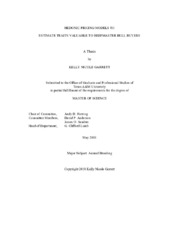| dc.description.abstract | Sire selection is a large financial investment for beef cow operations. Seedstock cattle producers desire knowledge regarding which traits impact differences in value or sale price among their customers. Bull sale data were collected from a purebred Beefmaster ranch in central Texas for five consecutive years (2012-2016, n = 521 records of 19 to 27 month old bulls). The buyers were classified by the sale host based on knowledge about their cow herds as (1) commercial or (2) seedstock/purebred; all bulls marketed were purebred and able to be registered by Beefmaster Breeders United. Data for these two buyer groups were analyzed separately through various hedonic models to understand important attributes affecting sale price. Each model utilized the same categorical variables, but alternate continuous variables were evaluated as: (1) animals’ performance trait values, (2) animals’ ratio values, or (3) animals’ EPD values, with a final prediction model developed for each buyer type. The final commercial buyer model had an R² value of 85%, but the final purebred buyer model had an R² value of 44%, indicating that bull price predictions in this dataset were easier to determine among commercial buyers. Commercial buyers placed more emphasis (P < 0.05) on the physical traits through conformation score on a 4-point scale (score 2 discounts of $1079.00 to $910.77 depending on the model), sire (P < 0.001) and maternal grandsire (P = 0.001) pedigree information, ribeye area ratio (-$40. 64 ± 14.667 for each 1% point increase), and quadratic form of weaning weight EPD ($4.86 ± 1.770). Purebred producers placed more emphasis (P < 0.05) on the birth season (age category) in which bulls were born ($3349.07 to $4810.73 higher for spring born bulls depending on the model), consignor or owner of the animal (-$2669.66 to -$2201.45 less for other consignors compared to the host ranch depending on the model), birth weight EPD (- $2793.00 to -$983.06 for each 1-lb increase), and quadratic form of yearling weight EPD ($8.13 to $10.47 depending on the model). In this dataset of Beefmaster bulls, class of buyer showed substantial differences in information preferences, and different levels of predictability; this is not surprising and is likely true in most breeds from different goals and intended uses across bull buyers. | en |


